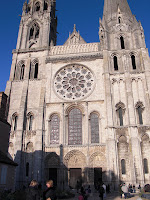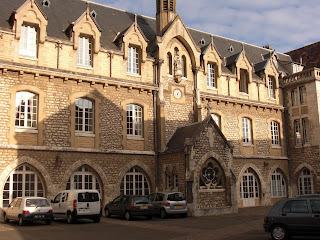
"Certainly, travel is more than the seeing of sights; it is a change that goes on, deep and permanent, in the ideas of living." - Miriam Beard, American humorist
(1901-1983)
Chartres! The familiar silhouette of its spires appears in ghostly form through the haze of an overcast day. More than 14 hours of planes, shuttles, trains, and buses melt away as we clamor our suitcases over the cobblestones toward the cathedral square and find our lodging in a hôtellerie run by the Diocese of Chartres. The courtyard of St.-Yves looks straight up at the apse (end of 
Deciding that a nap and shower can wait, I make my way into the cathedral for a peek, this time with eyes a little less ignorant about the story and form of the building. There’s the window with the Jesse Tree, there the famous blues of the Vièrge de la Belle Verrière (stained glass window with the Blessed Virgin), there the altar bearing the reliquary of the Sancta Camisia (Virgin Mary’s garment she wore when she gave birth to Jesus) brought to this site in 876 AD from Constantinople by Charles the Bald, grandson of Charlemagne – the fragile piece of silk that started all the fuss here in Chartres. The obscure cloth remnant, now ensconced behind glass and gold, became a revered object of pilgrimage for thousands of faithful from the early Middle Ages to the present. (Indeed, I met a lady from California at the hôtellerie who identified herself as a”pilgrim”.) Its miraculous escape from the flames that destroyed an earlier Romanesque basilica on this site spurred the construction of the present Gothic structure at the end of the 12th century.
A stroll outside the cathedral brings me to other familiar ornamentation. One is a column on the north portal, the statue of Abraham about to sacrifice his son Isaac. In marked distinction from its Romanesque predecessors, this sculpture is alive in emotion and animation. Knife in hand, Isaac turns his head sharply upward in response to a voice from heaven. There, just above the heads of the Old Testament figures who flank Abraham, is suspended the head of an angel that seems to drop out of position in its Gothic symmetry to deliver the heavenly reprieve. Abraham (as well as the other figures emerging from their bas relief as “columns” on the portals) stands on a symbol or element of his particular story: a sheep that would replace Isaac in sacrifice. I spot the Beau Dieu figure or
 the Beautiful God that welcomed the faithful at eye level as a benevolent, handsome deity incarnate, in stark contrast to Christ the Judge who oversees the weighing of souls at the portal of the Last Judgment. The entire story of man’s creation, fall from grace, and salvation is richly and exquisitely told in layers on this building. It should be read and digested in chapters to appreciate it all!
the Beautiful God that welcomed the faithful at eye level as a benevolent, handsome deity incarnate, in stark contrast to Christ the Judge who oversees the weighing of souls at the portal of the Last Judgment. The entire story of man’s creation, fall from grace, and salvation is richly and exquisitely told in layers on this building. It should be read and digested in chapters to appreciate it all!Mary Ann and I enjoy a pique-nique supper of (what else?) French bread and cheese and make our way to the cathedral this
 evening for a pièce de résistance: a concert given by a boys’ choir from Paris. Hearing sweet angelic voices singing the timeless tones of Schubert’s Ave Maria and other sacred works while sitting beneath the soaring vaults of Notre Dame de Chartres is a little piece of heaven on earth!
evening for a pièce de résistance: a concert given by a boys’ choir from Paris. Hearing sweet angelic voices singing the timeless tones of Schubert’s Ave Maria and other sacred works while sitting beneath the soaring vaults of Notre Dame de Chartres is a little piece of heaven on earth!




No comments:
Post a Comment